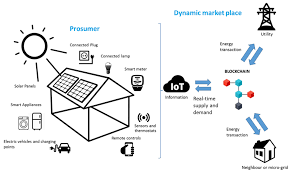
Blockchain technology has become increasingly popular due to its decentralized and secure nature, but one of the biggest criticisms it faces is its energy consumption. Proof of Work (PoW) blockchains, in particular, are notorious for consuming vast amounts of electricity, raising concerns about their environmental impact. However, there are ongoing efforts to make blockchain more energy-efficient and “green.” In this article, we will explore the environmental impact of blockchain, the challenges of energy consumption, and potential solutions for creating a more sustainable future for the technology.
The Environmental Impact of Blockchain
One of the most significant contributors to blockchain’s environmental impact is the PoW consensus mechanism. In PoW systems, such as Bitcoin, miners compete to solve complex mathematical puzzles to validate transactions and add new blocks to the blockchain. This process requires immense computational power, leading to high energy consumption. Bitcoin alone consumes more electricity annually than some entire countries, such as Argentina or the Netherlands.
The environmental consequences of such energy consumption are severe. Much of the electricity used by PoW blockchains comes from non-renewable sources like coal and natural gas, which produce large amounts of carbon dioxide (CO2) and contribute to global warming. This has led to widespread criticism of blockchain, with some arguing that the environmental cost of the technology outweighs its benefits.
Why Does Blockchain Consume So Much Energy?
The high energy consumption of PoW blockchains is primarily due to the nature of the mining process. Miners use powerful computers, known as mining rigs, to solve cryptographic puzzles. The more computational power a miner has, the greater their chances of solving the puzzle and earning a reward in the form of cryptocurrency. This creates a competitive environment where miners continuously upgrade their hardware to increase their chances of success.
As more miners join the network, the difficulty of the puzzles increases, requiring even more computational power and, consequently, more energy. This self-reinforcing cycle has led to a massive increase in the energy demands of PoW blockchains over the past decade.
Efforts to Improve Energy Efficiency
While the energy consumption of PoW blockchains is a significant concern, there are several efforts underway to improve the energy efficiency of blockchain technology. One of the most promising approaches is the adoption of alternative consensus mechanisms that are less energy-intensive than PoW.
Proof of Stake (PoS): PoS is an alternative consensus mechanism that requires participants to hold and “stake” a certain amount of cryptocurrency to validate transactions and create new blocks. Unlike PoW, PoS does not rely on miners solving puzzles, meaning it requires far less computational power and energy. Ethereum, the second-largest blockchain, is in the process of transitioning from PoW to PoS with the launch of Ethereum 2.0, which is expected to significantly reduce its energy consumption.
Delegated Proof of Stake (DPoS): DPoS is a variation of PoS in which a small group of trusted nodes, known as delegates, are selected by the community to validate transactions and maintain the blockchain. This reduces the number of participants involved in the validation process, leading to lower energy consumption. Blockchains like EOS and TRON use DPoS to achieve greater energy efficiency.
Layer 2 Solutions: Another approach to reducing the environmental impact of blockchain is the use of layer 2 scaling solutions. These solutions operate on top of the main blockchain and allow for transactions to be processed off-chain, reducing the load on the main network. Layer 2 solutions like the Lightning Network for Bitcoin and Optimism for Ethereum can help reduce the energy consumption of blockchains by making them more scalable and efficient.
Renewable Energy in Blockchain Mining
In addition to changing the consensus mechanism, some blockchain projects and mining operations are exploring the use of renewable energy to power their activities. By using solar, wind, or hydropower to generate electricity for mining, these operations can significantly reduce their carbon footprint.
For example, some Bitcoin miners have set up operations in regions with abundant renewable energy resources, such as Iceland and Quebec, where geothermal and hydropower energy is readily available. In these areas, miners can take advantage of low-cost, renewable electricity to run their mining rigs, reducing the environmental impact of their activities.
Several blockchain projects are also working to incentivize the use of renewable energy. For instance, the Energy Web Foundation (EWF) is developing a blockchain-based platform to track and verify the use of renewable energy in real-time. By creating a transparent and verifiable record of renewable energy usage, EWF aims to promote the adoption of clean energy within the blockchain industry.
Challenges to Achieving a Greener Blockchain
Despite the progress being made, there are still significant challenges to making blockchain truly energy-efficient. One of the main challenges is the resistance to change from established PoW blockchains like Bitcoin. Many in the Bitcoin community are reluctant to adopt alternative consensus mechanisms due to concerns about security and decentralization.
Another challenge is the scalability of renewable energy solutions. While some mining operations have successfully transitioned to renewable energy, the majority of blockchain mining still relies on non-renewable sources. Scaling up renewable energy usage across the entire industry will require significant investment and infrastructure development.
The Future of Green Blockchain
Despite these challenges, the future of blockchain is likely to be greener as the technology continues to evolve. The transition to PoS by major blockchains like Ethereum, the development of more energy-efficient consensus mechanisms, and the growing adoption of renewable energy in mining operations all point to a more sustainable future for blockchain.
Governments and regulators are also starting to take notice of the environmental impact of blockchain. In some regions, there are discussions about implementing policies to encourage the use of renewable energy in blockchain mining or to impose limits on energy consumption.
Conclusion
Blockchain technology has the potential to transform industries and create a more decentralized and secure world, but its environmental impact cannot be ignored. The energy consumption of PoW blockchains like Bitcoin is a significant concern, but there are promising solutions on the horizon. By adopting more energy-efficient consensus mechanisms, utilizing renewable energy, and developing layer 2 solutions, the blockchain industry can work toward a greener and more sustainable future. As the technology continues to evolve, it is essential for blockchain developers, miners, and policymakers to prioritize sustainability and address the environmental challenges facing this transformative technology.







